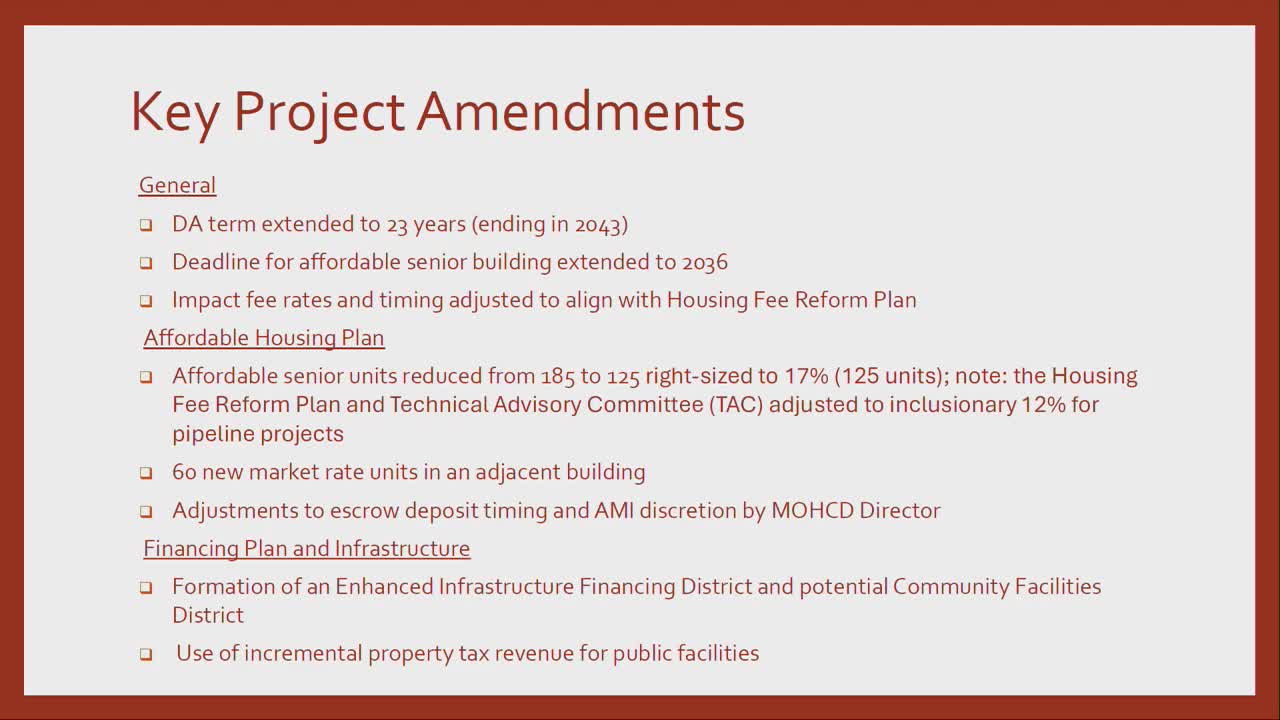City Council approves amendments for 1,300 housing units and infrastructure financing
October 30, 2024 | San Francisco County, California
This article was created by AI summarizing key points discussed. AI makes mistakes, so for full details and context, please refer to the video of the full meeting. Please report any errors so we can fix them. Report an error »

The San Francisco County government meeting held on July 4, 2025, focused on proposed amendments to a development agreement aimed at enhancing housing availability in the city. The agenda included discussions on two significant projects: the 333 California Street and 3700 California Street developments, which together are set to deliver over 1,300 housing units in a historically underserved area.
The meeting began with a presentation on the proposed amendments, which aim to align impact fees and affordable housing components with current code expectations. Notably, the senior affordable housing building's size will be reduced from 185 to 125 units, with the remaining 60 units designated as market-rate housing. This adjustment is intended to make the project more competitive for subsidies and grants.
The term of the development agreement will be extended by eight years, totaling 23 years, and a new financing plan will be introduced. This plan outlines the terms for implementing an Enhanced Infrastructure Financing District (EIFD) for both projects, which will facilitate the construction of public facilities and improve access in the neighborhood.
Key features of the developments include over three acres of public open space, a new 175-seat childcare center, and various street and pedestrian upgrades. The EIFD is expected to generate incremental property tax revenues that will support public infrastructure improvements and create new public connections in areas currently lacking accessibility.
The fiscal impact report presented during the meeting indicated a net fiscal benefit from the proposed district, with 50% of the incremental taxes generated allocated to the district and the other half to the city’s general fund. The meeting concluded with a request for approval of the proposed amendments and the EIFD resolution, which are seen as crucial steps in advancing housing production in the city.
In summary, the meeting underscored the collaborative efforts among project partners to address housing shortages in San Francisco, with a focus on balancing affordable housing needs and financial feasibility for developers. The next steps will involve further analysis and the formation process for the EIFD, as the city moves forward with these significant housing initiatives.
The meeting began with a presentation on the proposed amendments, which aim to align impact fees and affordable housing components with current code expectations. Notably, the senior affordable housing building's size will be reduced from 185 to 125 units, with the remaining 60 units designated as market-rate housing. This adjustment is intended to make the project more competitive for subsidies and grants.
The term of the development agreement will be extended by eight years, totaling 23 years, and a new financing plan will be introduced. This plan outlines the terms for implementing an Enhanced Infrastructure Financing District (EIFD) for both projects, which will facilitate the construction of public facilities and improve access in the neighborhood.
Key features of the developments include over three acres of public open space, a new 175-seat childcare center, and various street and pedestrian upgrades. The EIFD is expected to generate incremental property tax revenues that will support public infrastructure improvements and create new public connections in areas currently lacking accessibility.
The fiscal impact report presented during the meeting indicated a net fiscal benefit from the proposed district, with 50% of the incremental taxes generated allocated to the district and the other half to the city’s general fund. The meeting concluded with a request for approval of the proposed amendments and the EIFD resolution, which are seen as crucial steps in advancing housing production in the city.
In summary, the meeting underscored the collaborative efforts among project partners to address housing shortages in San Francisco, with a focus on balancing affordable housing needs and financial feasibility for developers. The next steps will involve further analysis and the formation process for the EIFD, as the city moves forward with these significant housing initiatives.
View full meeting
This article is based on a recent meeting—watch the full video and explore the complete transcript for deeper insights into the discussion.
View full meeting
